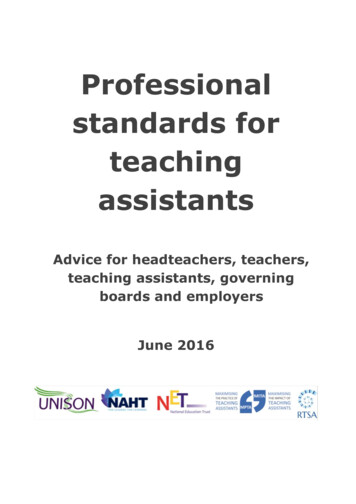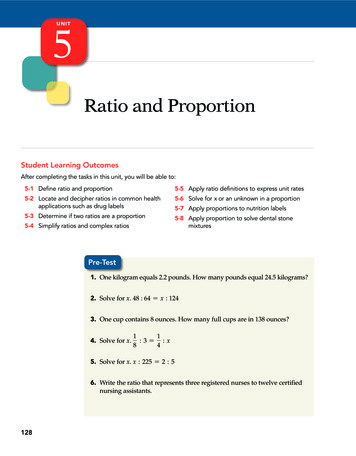
Transcription
Professionalstandards forteachingassistantsAdvice for headteachers, teachers,teaching assistants, governingboards and employersJune 2016
ContentsIntroduction3Who is this advice for?4Purpose of the standards4Overview of roles5What is a teaching assistant?5The role of the teaching assistant5The role of school leaders5The four themes6Personal and professional conduct7Knowledge and understanding7Teaching and learning8Working with others8Supporting guidance9Who are the standards for?9What are the standards for?9What are the standards not for?9Using the standards10Further information11Teaching assistant deployment11Teaching assistants – careers, training and development11NJC job profiles112
IntroductionThe Professional Standards for Teaching Assistants were originally drafted by a workinggroup set up by the Department for Education (DfE) in conjunction with organisationsrepresenting the schools workforce, practitioners and others also committed to ensuringexcellence in education. After completing the standards the government decided not topublish them and so a number of organisations interested in promoting the work ofteaching assistants asked the DfE for permission to publish them. Permission wasgranted subject to it being made clear that the DfE was no longer involved in theproduction of the standards, which we are happy to do.These teaching assistant standards are non-mandatory and non-statutory, but they sitalongside the statutory standards for teachers and headteachers and help to define therole and purpose of teaching assistants to ensure that schools can maximise theeducational value and contribution of employees working directly with pupils. As such, webelieve that they provide a valuable tool for the whole school team. We aim for thesestandards to benefit you, your colleagues and your pupils.This document provides the standards themselves as well as supporting guidancedetailing how the professional standards for teaching assistants should and should not beused. The standards should help teaching assistants and their colleagues in schoolsdefine and understand their role and are enhanced when underpinned by a professionalapproach from school leaders to employing and deploying teaching assistants to ensurethat educational outcomes are raised.Please note these standards will be most effectively used when read and implementedalongside the materials referenced in the ‘Further Information’ section on page 12.These standards could not have been published without the hard work of the originalreview team. The details of the original review panel’s remit and members can be foundhere.These standards are endorsed by UNISON, NAHT (National Association of HeadTeachers), NET (National Education Trust), London Leadership Strategy, EducationEndowment Foundation and Maximising TAs, with involvement and support from RobWebster (UCL Institute of Education), Paula Bosanquet (University of East London),Maria Constantinou, schools-based practitioner, and Dame Kate Dethridge NLE,Headteacher of Churchend Academy Teaching School (home of the Reading TeachingSchool Alliance) and former chair of the DfE working group that drafted the standards.3
Who is this advice for?This guidance is for: Teaching assistants, teachers and school leadersGoverning boards and employersLocal authority support servicesThese standards are applicable to all teaching assistants in schools, working at all levels.It is hoped these standards will support and shape positive conversations teachingassistants have with colleagues, managers and headteachers around their own roles andprofessional development.Please note this advice and guidance refers to ‘schools’ throughout. This includes allschools whether funded via the local authority (‘maintained schools’ or voluntary aidedschools) or via the Education Funding Agency (academy schools and free schools etc.).Purpose of the standardsThe Professional Standards for Teaching Assistants (2016) defines high standards whichare applicable to all teaching assistant roles in a self-improving school system. The mainpurpose of these standards is to raise the status and professionalism of teachingassistants and to position their role within a community of professionals, includingteachers and school leaders, all working together to improve outcomes for children.The teaching assistants’ standards were developed out of a review of the teachers’ andheadteachers’ standards by independent groups. The publication of these standardsrecognises that existing standards for Higher Level Teaching Assistants (HLTAs) do notapply to all teaching assistants. These standards do not replace the professionalstandards for HLTAs; they are complimentary to them (see Further information).National Occupational Standards for staff supporting teaching and learning provide adetailed framework for the training and development of support staff. They provide moredetailed insights and guidance (see Further information).This is a set of standards for teaching assistants that: are unequivocal, clear and easy to understand and use;can be used to inform performance management processes;steer the professional development of teaching assistants at all levels;are designed to inspire confidence in teaching assistants and ensure that schools usetheir skills and expertise to best effect;focus primarily on the key elements of their professional relationship with teachers toensure that all pupils attain the highest possible standards.4
Overview of rolesWhat is a teaching assistant?A number of different job titles are used for staff supporting teaching and learning. Thisdocument refers to “teaching assistants” throughout and this includes staff based in theclassroom for learning and pupil support, e.g. HLTAs, teaching assistants, special needssupport staff, early years practitioners, minority ethnic pupils support staff and bilingualassistants. While most teaching assistants are employed directly by schools andacademies, some are employed by local authority services and academy chains andwork across a range of schools and settings.The role of the teaching assistantThe primary role of the teaching assistant should be to work with teachers to raise thelearning and attainment of pupils while also promoting their independence, self esteemand social inclusion. They give assistance to pupils so that they can access thecurriculum, participate in learning and experience a sense of achievement.Teaching assistants are an integral part of the school workforce representing asubstantial investment of school funding. School leaders’ decision-making about theeffective deployment of teaching assistants is crucial in making a difference to pupilachievement (see Further information). Teaching assistants should act with honesty andintegrity to uphold comparable standards to other education professionals, in order tomake the education of pupils their first concern. By demonstrating values and behavioursconsistent with their professional role, teaching assistants work with other educationprofessionals within a common framework of expectations.The role of school leadersSchool leaders have a crucial role to play in the raising the status of teaching assistants.These standards provide school leaders with a tool to ensure consistency for all teachingassistants, so their skills and expertise in raising pupil achievement are recognised anddeveloped.Active and practical application of the standards demonstrates that school leadersrecognise the value and importance of teaching assistants and should ensure teachingassistants have parity of esteem with fellow education professionals. However, it shouldbe understood that adopting and using the standards in isolation is insufficient to theoverall aim of delivering good outcomes for pupils.These standards form an essential part of wider, complementary guidance to assistschool leaders’ strategic and operational decision-making, such as the Making Best Useof Teaching Assistants guidance report from the Education Endowment Foundation(EEF). This report sets out the best available evidence on the effective deployment of5
teaching assistants and recommendations on how best to utilise their skills, knowledgeand expertise in schools.The effective deployment of teaching assistants, and appropriate preparation for thetasks they undertake, is the key to their success in supporting teaching and learning.School leaders should not only ensure that teaching assistants have the right knowledgeand skills to provide effective teacher and pupil support, via appropriate and timelytraining and professional development, but also ensure that teachers are informed andequipped to fully capitalise on teaching assistants’ professional learning and expertise.School leaders and teachers should work to the principle that teaching assistants shouldbe deployed in ways that add value to what teachers do, not replace them.Meeting these standards depends on school leaders being able to provide a climate thatsupports forms of collaborative working that do not burden teachers or teachingassistants; and recognising that many teaching assistants manage other staff and requirethe time do this effectively. Teaching assistants require support and opportunities toreflect on their own practice in order to identify their training needs. Teaching assistantsshould have an appropriate career development pathway and access to training withinthe working day.The four themesThe Professional Standards for Teaching Assistants are set out in four themes.1.Personal and professional conduct2.Knowledge and understanding3.Teaching and learning4.Working with othersWithin each theme there are several standards expected of teaching assistants.Why were these themes chosen?Personal and professional conduct – In order for teaching assistants to provideeffective support to teachers and pupils, they need to be clear about their role andresponsibilities and how these fit within the wider structure of the school. In the sameway as teachers, teaching assistants operate in a position of trust and are seen by pupilsas role models. They should be able to maintain proper boundaries with pupils and theirbehaviours should reflect this responsible position.Knowledge and understanding – Teaching assistants should have sufficient knowledgeand skills to help teachers support pupils in achieving their maximum potential. Schoolleaders are best placed to make judgements about the type and level of knowledge andskills that individual teaching assistants need, as this will vary according to job role. Thiscould include: subject knowledge; specialist skills and knowledge to support pupils with6
special educational needs or disabilities; knowledge of the curriculum; pedagogicalknowledge; behaviour management strategies.Teaching and learning – An important role of a teaching assistant is to support theteacher in ensuring the best possible outcomes for all pupils. The standards in thistheme recognise that teaching assistants work under the supervision of a teacher inaccordance with arrangements made by the headteacher of the school. Schools shouldrefer to the EEF guidance report (see Further information) for ‘relevant strategies tosupport the work of the teacher’.Working with others – Teaching assistants work with other professionals, parents,carers and outside agencies as well as with pupils themselves. Although other themesrequire teaching assistants to work collaboratively with others, these qualities and skillswere considered so important and distinctive to the role as to merit their own theme.Personal and professional conductTeaching assistants should uphold public trust in the education profession by: Having proper and professional regard for the ethos, policies and practices of theschool in which they work as professional members of staff. Demonstrating positive attitudes, values and behaviours to develop and sustain effectiverelationships with the school community. Having regard for the need to safeguard pupils’ well-being by following relevant statutoryguidance along with school policies and practice. Upholding values consistent with those required from teachers by respecting individualdifferences and cultural diversity. Committing to improve their own practice through self-evaluation and awareness.Knowledge and understandingTeaching assistants are expected to: Share responsibility for ensuring that their own knowledge and understanding isrelevant and up to date by reflecting on their own practice, liaising with school leaders, andidentifying relevant professional development to improve personal effectiveness. Take opportunities to acquire the appropriate skills, qualifications, and/or experiencerequired for the teaching assistant role, with support from the school/employer. Demonstrate expertise and skills in understanding the needs of all pupils (includingspecialist expertise as appropriate) and know how to contribute effectively to the adaptationand delivery of support to meet individual needs. Demonstrate a level of subject and curriculum knowledge relevant to their role and applythis effectively in supporting teachers and pupils.7
Understand their roles and responsibilities within the classroom and whole schoolcontext recognising that these may extend beyond a direct support role.Teaching and learningTeaching assistants are expected to: Demonstrate an informed and efficient approach to teaching and learning by adoptingrelevant strategies to support the work of the teacher and increase achievement of all pupilsincluding, where appropriate, those with special educational needs and disabilities. Promote, support and facilitate inclusion by encouraging participation of all pupils inlearning and extracurricular activities. Use effective behaviour management strategies consistently in line with the school’spolicy and procedures. Contribute to effective assessment and planning by supporting the monitoring, recordingand reporting of pupil performance and progress as appropriate to the level of the role. Communicate effectively and sensitively with pupils to adapt to their needs and supporttheir learning. Maintain a stimulating and safe learning environment by organising and managingphysical teaching space and resources.Working with othersTeaching assistants are expected to: Recognise and respect the role and contribution of other professionals, parents andcarers by liaising effectively and working in partnership with them. With the class teacher, keep other professionals accurately informed of performanceand progress or concerns they may have about the pupils they work with. Understand their responsibility to share knowledge to inform planning and decisionmaking. Understand their role in order to be able to work collaboratively with classroom teachers andother colleagues, including specialist advisory teachers. Communicate their knowledge and understanding of pupils to other school staff andeducation, health and social care professionals, so that informed decision making can takeplace on intervention and provision.8
Supporting guidanceWho are the standards for?The standards are a tool for teaching assistants and for teachers and members of aschool leadership team responsible for managing their work. They are also intended tohelp employers and governors when recruiting support staff, and defining the job roles ofteaching assistants. They may also be useful to local authority support services andmulti academy trusts which employ teaching assistants. They are core standards for allteaching assistants working across all phases in mainstream and specialist settings.What are the standards for?These core standards are intended to raise the status and professionalism of teachingassistants. They define characteristics that all teaching assistants can demonstrateregardless of their working context. The standards are designed to ensure that the skillsand experience demonstrated by teaching assistants help to support high-qualityteaching, learning and social inclusion.The standards have been written to reflect the diversity of school employers and thewide-ranging responsibilities of teaching assistants working with pupils and teachers in avariety of contexts. They are designed for all teaching assistants and for schools to adaptto their own context.The standards are complementary to the existing standards for Higher Level TeachingAssistants (see Further information), rather than a replacement for them. The standardsprovide clear and concise expectations for all teaching assistants, working at all levels,and a framework to strengthen their status as education professionals.The standards may be used as a tool to support the performance management ofteaching assistants, although employers are free to decide the standards against whichteaching assistants are assessed.What are the standards not for?Whilst the standards may be used in support of any recruitment exercise, they should notbe used as a checklist. The standards are not appropriate for job evaluation; instead therole profiles developed by the National Joint Council for Local Government Services roleprofiles can be used (see Further information). The standards are generic and broadbased – they do not specify requirements for staff recruited to specialist roles.The standards should be considered as a whole. Although some standards may be moreimportant in some contexts, the professionalism and contribution of teaching assistantsneeds to be recognised in its entirety rather than under specific themes. The weight givento each element will vary from school to school and will depend on the individual job roleand responsibilities.9
Using the standardsThe standards can be used: For teaching assistants, to shape their own practice and professionaldevelopment, within and beyond the schoolSelf-evaluation in a supportive context is key to the development of all education professionals.These standards can be used by teaching assistants as a focus for reflection on their ownpractice.Teaching assistants can use the standards to have a constructive conversation withheadteachers, teachers and others about areas where support is needed for professionaldevelopment. Teaching assistants should feel empowered to seek such support. School leadersare expected to provide such training and support as may be necessary for the support staff intheir schools, as possible within the financial constraints in which they operate. For teachers or other line managers, to inform the appraisal of teachingassistantsThere is no mandatory requirement to use the standards for this purpose, but they provide auseful framework for appraisal discussions. These standards should not be used as prescribedobjectives. Objectives must be relevant to the context of the individual school and teachingassistant.They may be used to support and supplement existing appraisal frameworks, but are notdesigned as a sole tool for performance management.The standards should not be used to assess the performance of teaching assistants in the waythat teachers’ performance is assessed. The standards are not part of a statutory framework andteaching assistants do not have the same sort of pay and career structure as teachers. Thestandards should not be used for the purposes of accountability. Teaching assistants should notbe expected to provide evidence against each of the standards for appraisal For employers to support the recruitment and appointment of teachingassistantsThe standards are not an off-the-shelf job description or a person specification, but they can beused to underpin and shape both of these documents.It is important to focus on the context of the individual school. Different schools and teachingassistants within each school will have different levels of responsibility and so require differentskills and experience. For employers to evaluate their induction arrangements and provision ofcontinuous professional development (CPD) for teaching assistantsThe standards should inform schools’ processes for identifying training and development needs.Schools need to have CPD policies which effectively address the needs of the whole workforceand should use their own and external training budgets to this end.10
Further information (web links below)Teaching assistant deploymentEducation Endowment Foundation Guidance report: Making effective use of teachingassistantsDepartment for Education Effective deployment of classroom staffEducation Endowment Foundation Teaching and learning toolkitOfsted Deployment and impact of support staff (from 2010, not linked to currentinspection framework)Maximising TAsExisting standards for teaching assistantsHLTA standardsNational Occupational StandardsTeaching assistants – careers, training and developmentSkills for schoolsNJC job profilesNJC model role profilesTeachers’ and headteachers’ standardsTeachers’ StandardsHeadteachers’ StandardsOther resourcesStatutory policies for schoolsKeeping children safe in educationSEND Code of PracticeProfessional development standards for teachers (to be published 2016)11
reflect on their own practice in order to identify their training needs. Teaching assistants should have an appropriate career development pathway and access to training within the working day. The four themes The Professional Standards for Teaching Assistants are set out in four themes. 1. Personal and professional conduct 2. Knowledge and .










